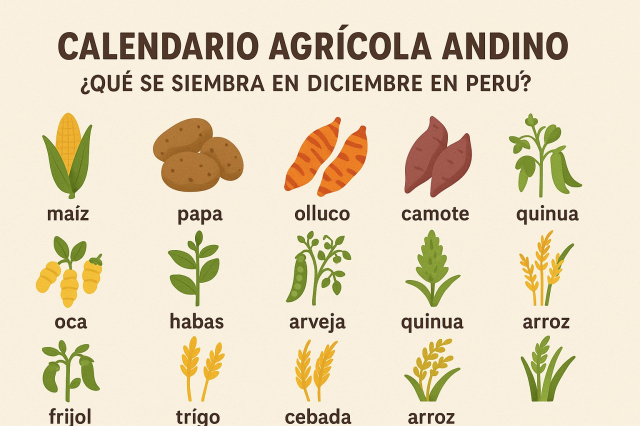December marks a key month in the Andean agricultural calendar , as it coincides with the beginning of the rainy season in much of Peru. For rural and farming communities, this month represents the rebirth of the land and the time to prepare the fields for a new productive phase.
Unlike the modern calendar, the Andean calendar is based on the observation of natural cycles: the stars, the moon, animal behavior, and soil moisture. This ancestral connection with nature defines the periods of sowing, growth, harvest, and rest of the land .
You can learn more about the relationship between agricultural time and the indigenous worldview in the Andean calendar: traditional celebrations and agricultural seasons in Peru .
The role of weather and rainfall in December
In the Andean region, December rains are considered a sign of abundance. In regions such as Cusco, Ayacucho, Puno, Apurímac, and Huancavelica, farmers await the arrival of the first rainfall to till the land and plant the main crops for the 2025–2026 agricultural cycle.
The climate varies according to altitude:
In high areas (more than 3500 m above sea level) , the cold limits some early sowing.
In inter-Andean valleys , the fertile soil allows for the planting of corn, potatoes and quinoa.
In the high jungle , December marks the second agricultural season, with fast-growing tropical products.
Main crops planted in December
Below are the most common agricultural products planted during December, according to the region of Peru:
| Region | Main crops | Characteristics |
|---|---|---|
| Southern Sierra (Cusco, Puno, Arequipa) | Potato, quinoa, bean, barley | Cold-resistant crops; initial moisture is used. |
| Central Sierra (Huancavelica, Junín, Ayacucho) | Corn, peas, barley, lentils | It is planted on terraces and family farms. |
| Northern Sierra (Cajamarca, Ancash) | White potato, wheat, starchy corn | The temperate climate favors rapid germination. |
| High Jungle (San Martín, Amazonas, Huánuco) | Banana, cassava, coffee, cocoa | The second sowing is carried out before the heavy rains. |
| Coast (Lima, Ica, La Libertad) | Cotton, sweet potato, corn, chili | Technical irrigation and planned planting for export are used. |
The influence of the moon on Andean sowing
The lunar calendar is of great importance in traditional agriculture. Peruvian farmers still observe the phases of the moon to decide when to sow, prune, or harvest.
🌑 New moon: favorable for planting tubers such as potatoes or oca.
🌓 First quarter: ideal for grains and legumes (corn, quinoa, beans).
🌕 Full moon: time of good humidity, used for leafy crops (spinach, lettuce, chard).
🌗 Waning quarter: time for clearing fields or harvesting roots.
You can check the December lunar calendar in Peru to find out the most favorable days for planting according to the lunar phases.
Agricultural rituals in December
Before planting, rural families perform rituals of gratitude to Pachamama . These acts, known as "payments to the earth ," seek to attract good harvests and harmony with the environment.
The most common elements in these offerings are:
Coca leaves and chicha de jora.
Wildflowers and dried grains.
Miniatures of animals or agricultural products.
These practices strengthen the spiritual relationship with nature and are part of the country's living cultural heritage.
How Andean farmers are preparing for the campaign
During December, farmers:
They clean and assemble the agricultural terraces .
They collect seeds from previous crops.
They prepare natural fertilizers and compost.
They bring communities together for mingas or collective planting work.
These community efforts strengthen social ties and keep the ancestral Andean organization alive.
Importance of the agricultural calendar in education and identity
The agricultural calendar not only guides rural work, but also rural festivals and school calendars , where vacations coincide with agricultural seasons. In many Andean schools, children learn to sow, irrigate, and harvest as part of their cultural education.
Thus, ancestral knowledge is passed down from generation to generation, reinforcing Peru's agricultural and cultural identity .
